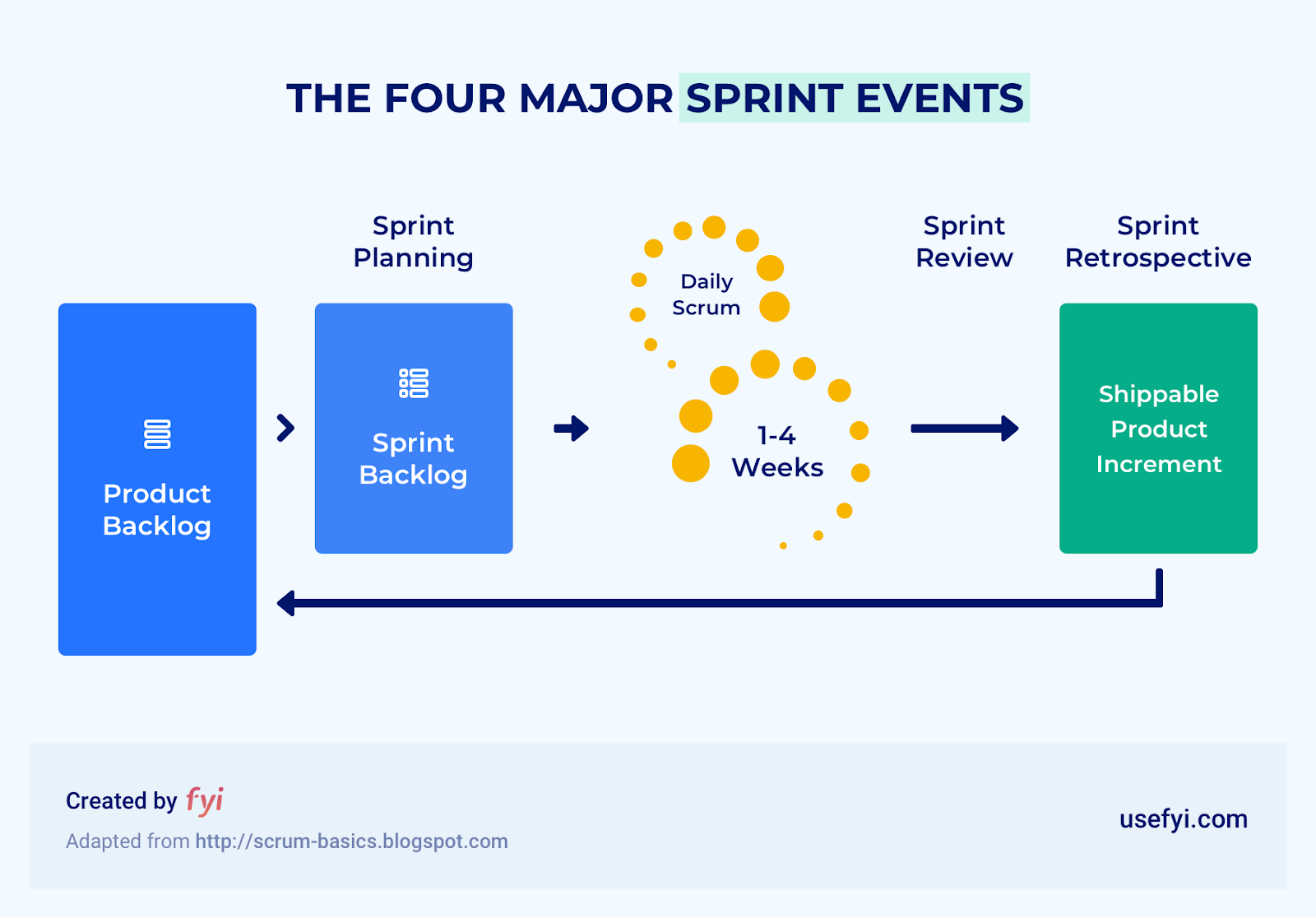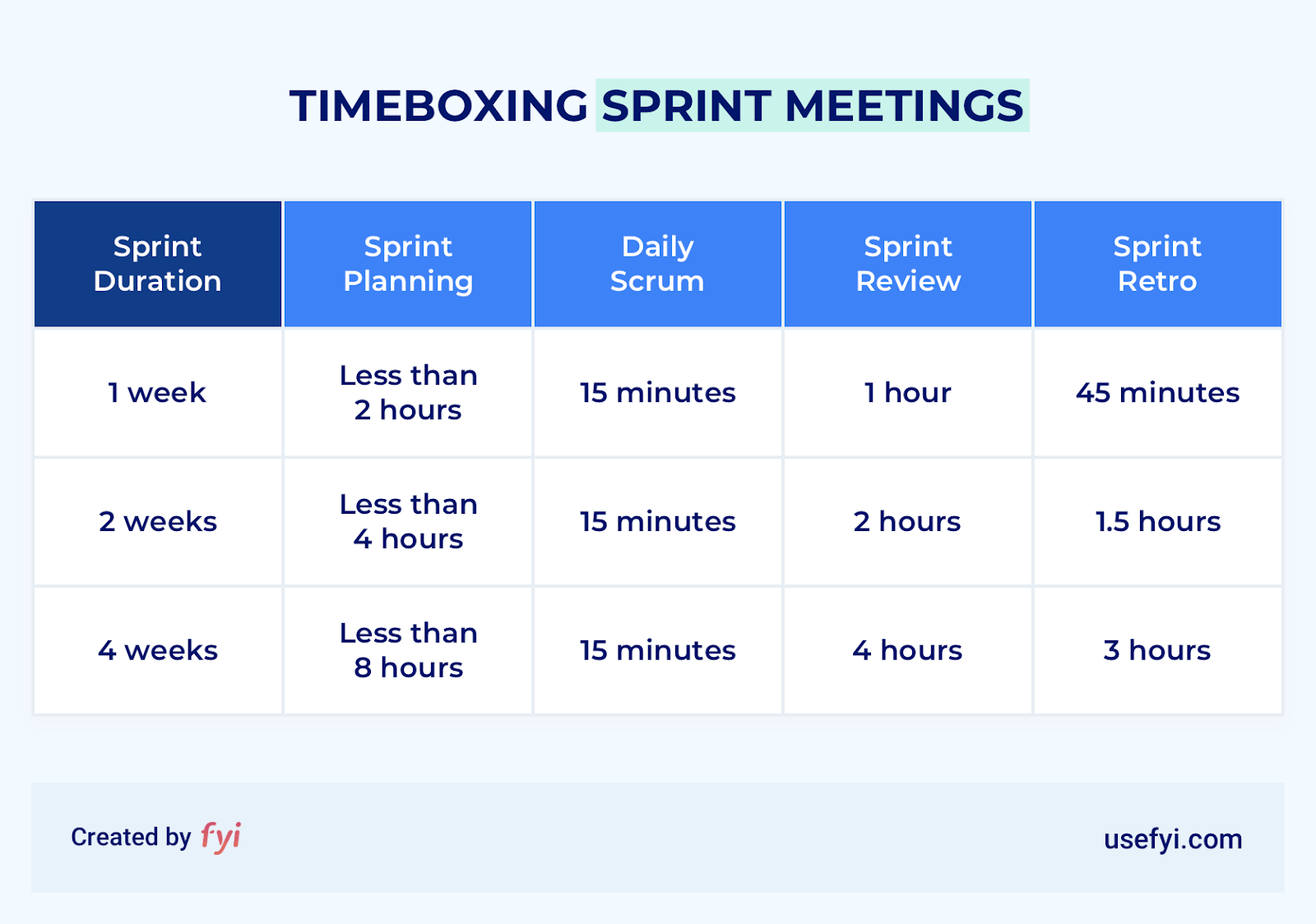How to Run the Perfect Scrum Meeting

Daily Scrum, Scrum meeting, Scrum standup… no matter what you call it, this 15-minute timeboxed meeting is one of the most important elements of your software development strategy.
Scrum meetings provide opportunities for teams to assess their work and adapt accordingly. Executed well, Scrum meetings alert the team to potential problems and keep the pace of development on track.
In this post, I’ll give you a sense of how to run a Scrum meeting by situating it within the larger Scrum framework of sprint events. From there, I’ll break down the steps for running a Scrum meeting and leave you with some strategies for adapting to your team’s needs.
Scrum and sprint events
Scrum is an agile framework for addressing problems. It doesn’t prescribe a development methodology so much as it lays out a system of organization, which can adapt to changing team and customer needs while continuously producing incremental product improvements.
Small groups of individuals known as Scrum teams execute sprints, which are usually one to four weeks in length. They are made up of a Scrum master, product owner, and development team. By the end of the sprint, the Scrum team is expected to complete a specific and realistic task from the backlog.
The backlog is composed of “user stories,” which are the product features and fixes users want. The team has to transform these user stories into tasks that will yield a shippable solution.
As I’ve talked about in other blog posts, Scrum teams need to be self-regulating and have the expertise they need to complete tasks without external help. Staying on track is extremely important, as is forecasting when the team is headed in the wrong direction.
So how does a Scrum team stay oriented?
The Scrum master is in charge of facilitating four major sprint events that bring the team together to coordinate their activity. Each event is an opportunity for improvement. And outside these, there should be minimal need for additional meetings.

Sprint Planning happens at the start of the sprint. This meeting includes the entire Scrum team. The product owner and development team decide together which items of the product backlog to deliver by the end of the sprint. Those items then become the sprint backlog. It must be manageable yet maximize the amount of work the team can get done.
By the end of sprint planning, the team:
- Defines the scope of the work to complete during the sprint and a uniform understanding of what “done” means.
- Establishes a plan of action for completing the work by the end of the sprint.
The Scrum master needs to keep this meeting short (roughly two hours per week included in the sprint) and to keep tabs on what needs to be accomplished as the sprint progresses.
Daily Scrum is a very quick meeting with the Scrum master and development team. It happens each day of the sprint. Below, I’ll dive deeper into how to run daily Scrums, but as it fits into the larger Scrum framework, daily Scrum is the most frequent opportunity teams get to inspect and adapt their processes as a team.
To that end, each team member should answer some variation of these three questions during daily Scrum:
- What did I accomplish since the last Scrum meeting?
- What am I supposed to accomplish today?
- What could prevent me from accomplishing my goals (impediments, vague objectives, external factors, and so on)?
The Scrum master has to keep daily Scrum even shorter. Except for unusual circumstances, the meeting should run 15 minutes or less. You might want a timer or a strict agenda. By the end of it, everyone should have a clear goal for their daily work.
Sprint Review is held at the end of the sprint with the whole Scrum team present. Other stakeholders may attend this meeting, if involved in the project. The “done” increment is discussed, as are adaptations to the development process in light of the team’s recent experience.
By the end of the sprint review, the team:
- Updates the backlog to reflect the “done” increment.
- Prioritizes backlog items for the upcoming sprint.
This is an informal, collaborative meeting, and should be relatively short (one hour per week included in sprint). Much of the work at this meeting will be useful during the next sprint planning session. So the Scrum master should be sure to store all notes and ideas for that sprint event.
Sprint Retrospectives come after the sprint review and before the next sprint planning. At this meeting, which usually includes the Scrum master and development team, the group reflects on the past sprint with the deliberate purpose of inspecting and adapting their process.
There are endless ways to do this (get a few ideas here), but the goal is to get the team thinking about what could be done to make the next sprint more productive and fun. Together, the team decides on changes they can make to perform better.
By the end of the retrospective, teams will have:
- A list of action items to implement during the next sprint
- Metrics for determining the success of action items
- Key takeaways from the meeting
Retrospectives should be kept to three hours or less for a standard four-week sprint. Shorter sprint durations will likely require less time, but I wouldn’t recommend cramming it into anything less than 30 minutes. Another important note: Scrum masters are responsible for facilitating sprint retrospectives, but they should not be doing much of the talking.
Timeboxing sprint meetings

From the table you can get a general sense of the meeting breakdown throughout the sprint. The purpose of routinizing sprint events and capping their duration: to make sure there is a predictable forum for folks to bring concerns to the team.
As the most frequent of all sprint events, daily Scrums provide the most opportunities to make changes. Now that you know how they function within the sprint, let’s talk about how to run them well.
How to keep daily Scrum meaningful
Regardless of how you want to structure your daily Scrum, make sure the entire team knows when and where you are planning to meet. Keep these meetings as regular as possible—the same place, at the same time, every weekday.
Tip: Running your first Scrum meeting? Or meeting with your team for the first time in a new location? Double check the room is reserved and equipped with the seating and brainstorming tools you need.
I know it sounds simple—and the scheduling part of it is—but making daily Scrums regular is key to the agile process. Your team should be prepared to use this brief time to address yesterday and plan today. It’s not easy. The complex and collaborative and work of daily Scrums is only possible if the team comes in with relevant observations.
Ask yourself:
- Is your team working throughout the day with a shared understanding of tasks?
- Can they accurately self-assess their work and capabilities?
Team members should understand the point of daily Scrums and get comfortable with regularly sharing concerns with each other.
What about ‘standup’ Scrum meetings?
Scrum meetings are often conducted standing. And it makes sense—making people stand encourages brevity. Some teams even use the standup format for other types of meetings they are trying to keep short.
In my opinion, you should go with what works. If your daily Scrum is starting to exceed 15 minutes, maybe try a standup. If your team does just fine around a conference table, that’s cool too. It might be easier to take notes that way, for example.
A step-by-step for conducting daily Scrum
The team has arrived. You have 15 minutes, tops, before everyone heads back to their desk or water cooler.
What can you do to make your daily Scrum productive?
1. Start (and stop) on time
If the Scrum meeting is scheduled at 9 am, that’s when the Scrum meeting starts. Don’t wait for latecomers. When you only have 15 minutes, punctuality is key.
Likewise, the meeting needs to end on schedule. It’s respectful of individuals’ time and lets them accurately plan ahead for their own day.
2. Set an agenda, stay on track
Unless your team is brand new to working together, they should walk through the door knowing what input they are expected to provide. To inspect the work so far and adapt the plan for the day, each team member shares answers to the three questions I mentioned above:
- What did you complete yesterday?
- What will you complete today?
- What stands in your way?
You may want to vary your Scrum meeting structure a bit from time to time—to keep meetings from getting stale or to address a specific issue. That said, these meetings will best track progress and troubleshoot issues within a clearly defined scope.
3. Close daily Scrum with direction
The goal is to make sure folks can complete their work before the next Scrum meeting. Make sure that:
- Team members know their responsibilities
- Vague goals have been defined in specific terms
- Open-ended questions have been answered—at least tentatively
- Uncertainties are brought to light
The Scrum master should also make sure team members have access to an updated Scrum board that reflects decisions made during daily Scrum. Whether physical or virtual, this shared point of reference is essential to coordinating tasks.
3 things to avoid during daily Scrum
As you now know, there is little room during daily Scrum for anything besides key discussion points. But daily Scrum can (and does) go off the rails. Watch out for these pitfalls:
1. Ramblers and monopolizers
Everyone’s ideas are important and that’s why the whole team needs to be able to speak during daily Scrum. Remember, over-contributors take the floor away from the collective needs of the team.
Keep a timer to hand. Some online tools for retrospectives integrate those and more.
2. Unsafe space
The Scrum team needs to operate with transparency and honesty. If folks don’t feel safe speaking up, important concerns stay under the radar. Individuals must feel empowered to share news about their work—good and bad—for the team to adapt as needed.
Scrum values people over processes, and this involves listening and paying attention to the team. Here are a few tips for creating a Scrum-friendly environment.
3. Mission creep
Try not to broaden the purpose of daily Scrum. It’s not a time for new product ideas or one-on-one conversations. Great ideas come up, of course, but unless they are relevant to the work at hand, you can build on them later.
As Scrum master, you can make a quick note of ideas to revisit or questions to raise during sprint review. Keeping everyone on a tightly focused mission during daily Scrum does not mean you have to shut them down.
Interested in learning more about how to run Scrum meetings? You might want to think about getting a Scrum master certification to build your knowledge of Scrum, and to connect with others in the community who honed their skills over decades.

